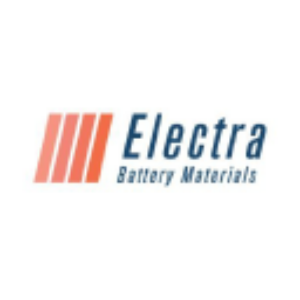Electra Provides Update on Black Mass Recycling
“Throughout this 12-month demonstration operation, our team has continued to refine and optimize the processes resulting in successive improvements to the saleable products. These results support our thesis that Electra’s battery materials recycling flow sheet could be an important contributor to our refinery operations,” said Electra’s CEO, Trent Mell. “The Ontario refinery is a unique asset that can be expanded on a modular basis, leveraging existing permits and infrastructure. As the transition continues toward green energy solutions and electrification, the supply of material in need of recycling will increase. Electra’s technical team successfully operated the first refinery in
Recent Black Mass Optimizations:
-
Electra has improved its lithium carbonate product quality by nearly
20% from its initial processing and product quality is now approaching “technical grade” lithium carbonate. Discussions are ongoing with lithium companies to assess the tradeoffs between collaboration or producing a technical grade in-house. -
Manganese recovery rate has been further improved to approximately
95% by strategically modifying the use and sequencing of reagents. -
Continued refinements to the process parameters for the nickel-cobalt mixed hydroxide precipitate (MHP) produced from the recycling process have at times improved paymetal concentration in the final MHP product to nearly
50% nickel and cobalt, well above quoted market standards. Improved metal concentration creates the opportunity to generate a higher metal payable, thereby improving the potential economics of continuous recycling operations. - Continued optimization studies are underway, including metal recovery from internal recycling streams such as reusing tailings water as process water to feed the plant, thus making the process entirely closed circuit with minimal environmental impacts.
- Preliminary results of laboratory work to explore the potential of isolating cobalt from nickel contained in the leach liquor using hydrometallurgical methods are positive. Isolating the cobalt could improve the overall payability of both the resultant cobalt and nickel product.
Electra launched a black mass trial late in 2022 at its
The Company has developed proprietary hydrometallurgical technology that targets all of the critical minerals present in the black mass as saleable products. Once recovered, the products can further be upgraded to battery grade materials and reused by gigafactories to produce batteries or other products.
Additional Black Mass Program Highlights:
-
Electra has processed 40 tonnes of black mass material in a plant scale setting, believed to be the first of its kind in
North America . - Recovery rates for all targeted metals – lithium, nickel, cobalt, graphite, and manganese - have improved since the start of the trial in December 2022.
- Approximately 28 tonnes of nickel-cobalt MHP product have been shipped to customers.
- Reagent requirements were reduced and in some cases alternative, less costly, reagents were used for improved overall metal recovery. Further, some of the reagent additions substituted have reduced overall impurity levels within the process. The reduction in reagent use and substitution of certain reagents are expected to lower operating expenses, thereby improving the economics of continuous recycling operations.
Black mass is the industry term used to describe the material remaining once expired lithium-ion batteries are shredded and all casings removed. Black mass contains high-value elements, including lithium, nickel, cobalt, manganese, copper, and graphite, that once recovered, can be recycled to produce new lithium-ion batteries.
Established North American battery recyclers have focused on collecting and shredding of batteries with the resulting black mass material primarily exported, or treated by a pyrometallurgical smelting process that has a higher carbon footprint and lower metal recoveries than hydrometallurgical processes.
About Electra Battery Materials
Electra is a processor of low-carbon, ethically sourced battery materials. Currently focused on developing North America’s only cobalt sulfate refinery and a black mass demonstration plant, Electra is executing a multipronged strategy to onshore the electric vehicle supply chain. Keys to its strategy are integrating black mass recycling and nickel sulfate production at Electra’s cobalt refinery located north of
Neither the TSX Venture Exchange nor its Regulation Services Provider (as that term is defined in policies of the TSX Venture Exchange) accepts responsibility for the adequacy or accuracy of this release.
Cautionary Note Regarding Forward-Looking Statements
This news release may contain forward-looking statements and forward-looking information (together, “forward-looking statements”) within the meaning of applicable securities laws and the United States Private Securities Litigation Reform Act of 1995. All statements, other than statements of historical facts, are forward-looking statements. Generally, forward-looking statements can be identified by the use of terminology such as “plans”, “expects”, “estimates”, “intends”, “anticipates”, “believes” or variations of such words, or statements that certain actions, events or results “may”, “could”, “would”, “might”, “occur” or “be achieved”. Such forward-looking statements include, without limitation, statements regarding the potential for additional funding from the Federal government of
View source version on businesswire.com: https://www.businesswire.com/news/home/20240205109937/en/
Heather Smiles
Vice President, Investor Relations & Corporate Development
info@ElectraBMC.com
1.416.900.3891
Source: Electra Battery Materials Corporation






